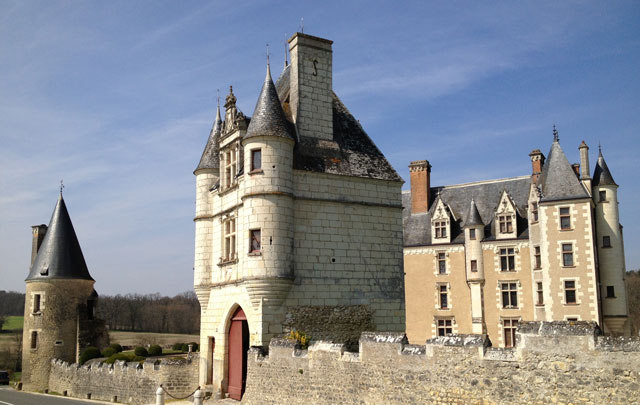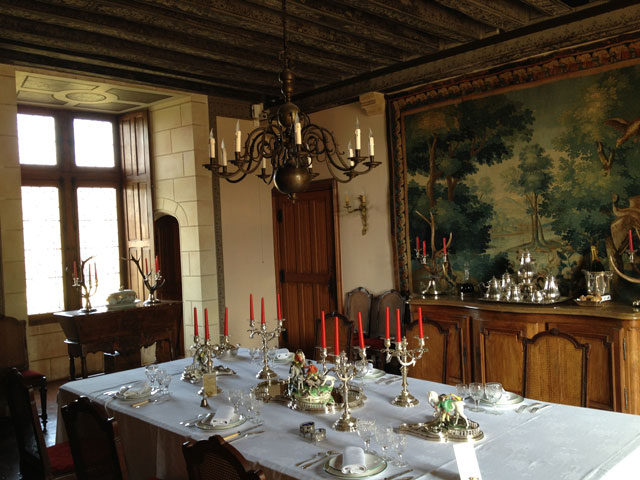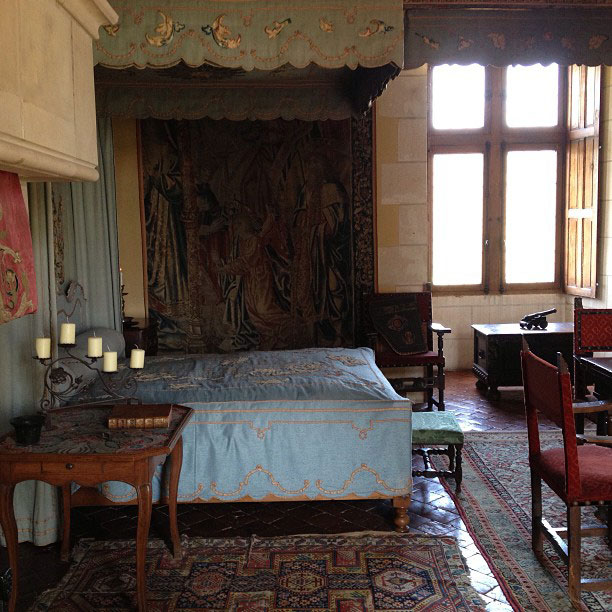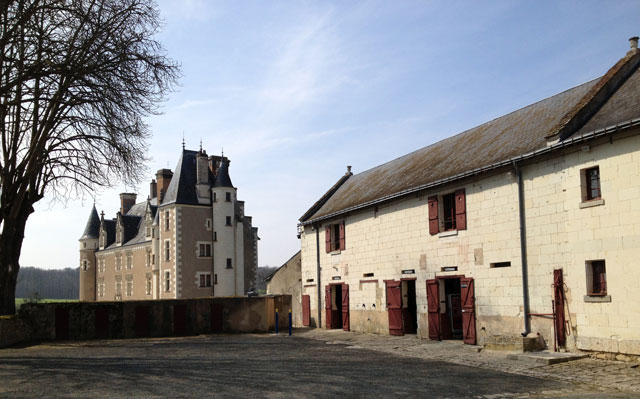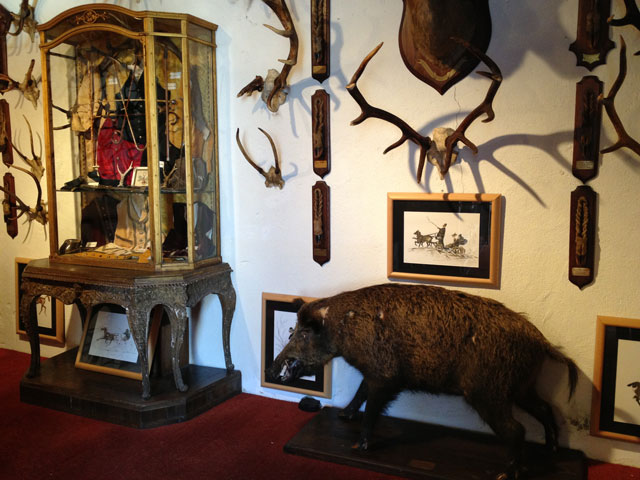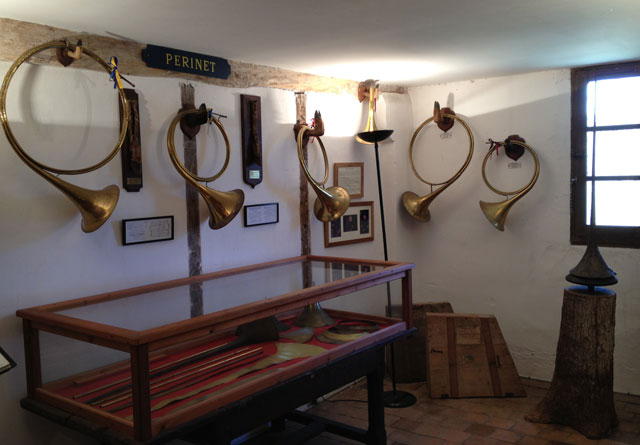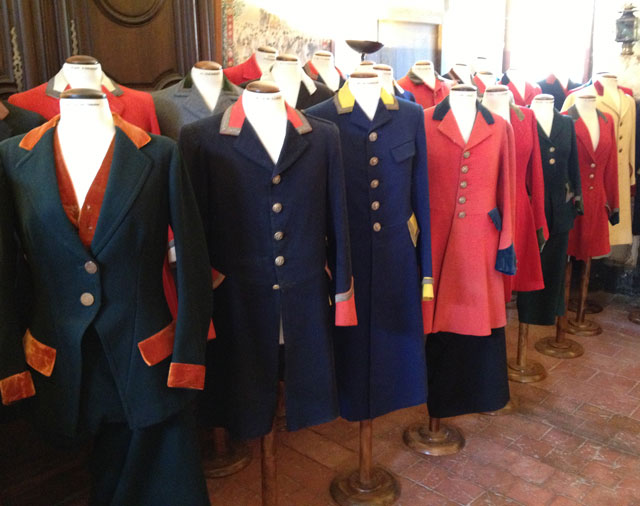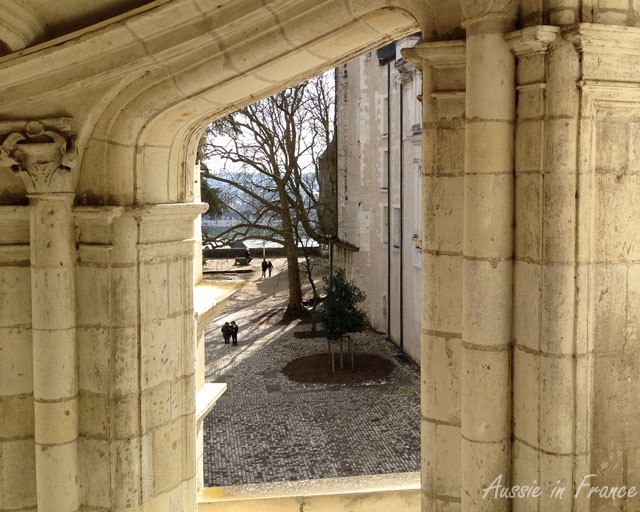

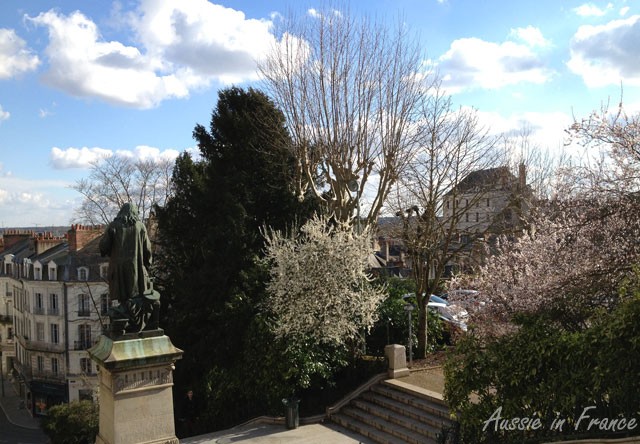
This week’s Blogger Round-Up starts in the city of Nice on the French Riviera with Phoebe from Lou Messugo who shares her stunning photos of Nice Carnival. And to give you another view of Nice, Margo Lestz, writing for The Good Life France, explains the origin of The Bay of Angels and other place names. In a different part of the country altogether, Susan from Days on the Claise tells us the fascinating history of Van Loos’ painting of The Three Graces in Chenonceau. Enjoy!
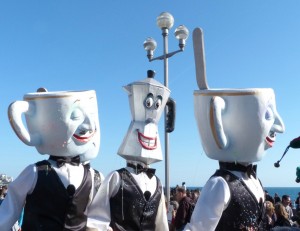 We couldn’t have asked for a more perfect day to go to Nice Carnival 2014. Under the bluest of blue skies we spent a fun afternoon watching the the creative, witty and satirical floats pass by united under the theme of gastronomy. Being our 5th or 6th time at Carnaval we recognised some of the regulars – the roaring dragon, the confetti seller who comes to the school fête, the OGCN (Nice football team) supporters with balloon boobs, the man dressed as a caveman hauling a ragdoll around, the Italian flag throwers – we felt like real locals. As always the floats represented contemporary issues and cultural icons. Amongst others Angela Merkel could be seen devouring Portugal, Spain and Greece. Read more
We couldn’t have asked for a more perfect day to go to Nice Carnival 2014. Under the bluest of blue skies we spent a fun afternoon watching the the creative, witty and satirical floats pass by united under the theme of gastronomy. Being our 5th or 6th time at Carnaval we recognised some of the regulars – the roaring dragon, the confetti seller who comes to the school fête, the OGCN (Nice football team) supporters with balloon boobs, the man dressed as a caveman hauling a ragdoll around, the Italian flag throwers – we felt like real locals. As always the floats represented contemporary issues and cultural icons. Amongst others Angela Merkel could be seen devouring Portugal, Spain and Greece. Read more
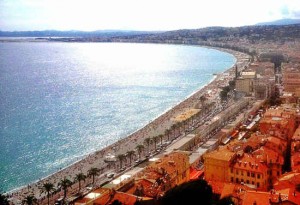 Many rich and famous tourists visit Nice every year, but according to a legend, the first visitors were actually Adam and Eve – yes, the ones from the Bible.
Many rich and famous tourists visit Nice every year, but according to a legend, the first visitors were actually Adam and Eve – yes, the ones from the Bible.
As the story goes, after they were kicked out of Paradise for being naughty, they were standing outside the locked gates looking at their new hostile surroundings. Everywhere was barren and inhospitable. They had no idea where to go or what to do. Then they heard the sound of rustling wings, looked up to see a band of angels flying overhead motioning to them. The angels flew across the waters and hovered over a certain spot – they were showing the couple a glorious bay, in front of a land that was as lush and beautiful as the Eden they could no longer enter. Read more
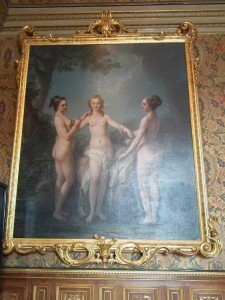 There is a large painting depicting three naked women hanging in one of the salons of Chenonceau. It’s called The Three Graces and is by Carle Van Loo (not his brother Jean-Baptiste, despite the frequency you will find it attributed to him on the internet). It is widely believed to depict three of the five de Nesle sisters, but since it is clearly a picture of three attractive young women, there is a certain amount of debate about the identification of the notorious sisters and the subject of this painting. The de Nesle sisters, with the exception of the youngest, were not considered to be beauties, were all long dead by the time the picture was painted and Van Loo wasn’t known for being kind to his subjects. Read more
There is a large painting depicting three naked women hanging in one of the salons of Chenonceau. It’s called The Three Graces and is by Carle Van Loo (not his brother Jean-Baptiste, despite the frequency you will find it attributed to him on the internet). It is widely believed to depict three of the five de Nesle sisters, but since it is clearly a picture of three attractive young women, there is a certain amount of debate about the identification of the notorious sisters and the subject of this painting. The de Nesle sisters, with the exception of the youngest, were not considered to be beauties, were all long dead by the time the picture was painted and Van Loo wasn’t known for being kind to his subjects. Read more
We went to visit Mr and Mrs Previous Owner recently and I wanted to know what they did to get rid of the moss on the front stairs. “Sur le perron“, replied Mr Previous Owner. “No, the front steps”. “Oui, le perron“, he insisted.
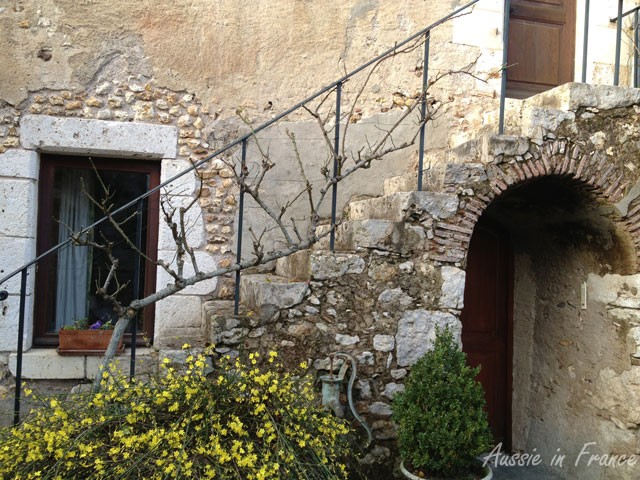
And here I had been labouring under the misconception all these years that the perron was something quite different. According to my Larousse dictionary, it is an outside staircase with a small number of steps ending in a platform leading to a front door, as can be seen in the following photo.
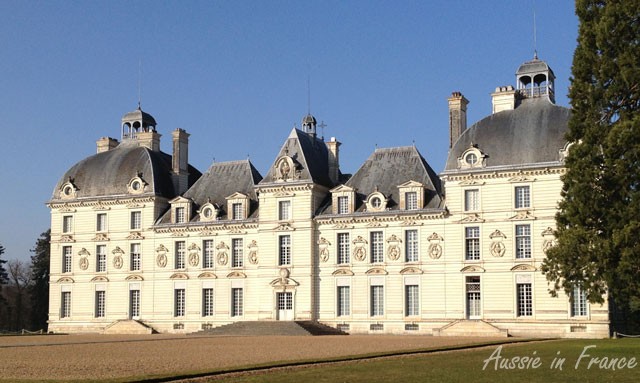
I check my Dicobat building dictionary and it doesn’t mention anything about the number of steps, so I can now talk about “notre perron”. As far as I know, we have nothing in English to describe this concept.
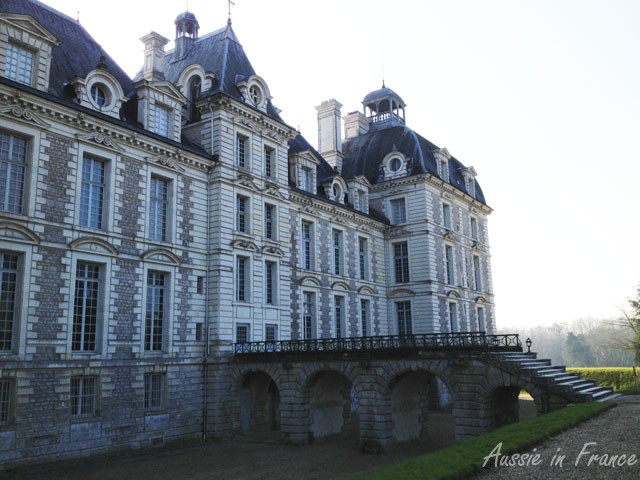
On another but slightly related subject, we’ve been looking for a solution for some time to stop treading mud into the house when it rains, particularly in winter. The area in front of the house is a combination of grass and gravel with no clear delineation.
We recently went to Truffaut to see what we could find. There was a large selection of pas japonais (pas meaning step in this context). For some reason, I thought that pas japonais were slightly staggered to the left and right to naturally follow your steps.
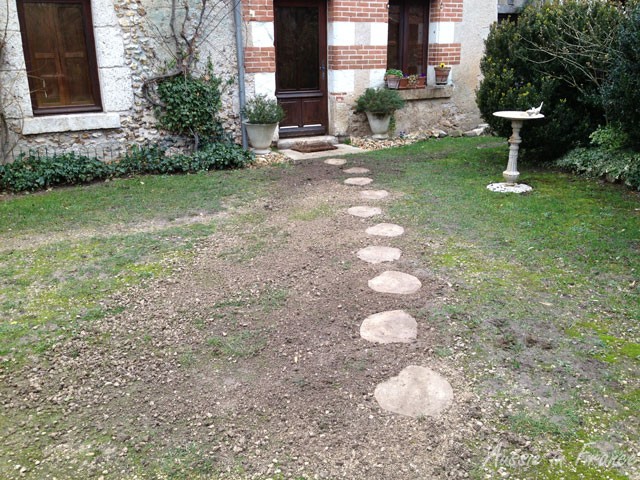
After buying the last 10 pas we liked, we laid them in light rain and I posted a photo on Facebook. “I would call them stepping stones”, said a friend. She’s right of course. I was so disappointed. We’ve ordered some more for the rest of the garden but I can see we’ll have to lay the other ones again. It’s so annoying trying to remember whether you should be starting with your left leg or your right leg. Sigh.
We kept on passing Château de Beauregard when cycling to Chambord and Cheverny, so we finally scheduled a visit on a Sunday morning in March. We were surprised to run into friends from Montrichard who had just finished their visit! It’s a small world, isn’t it?
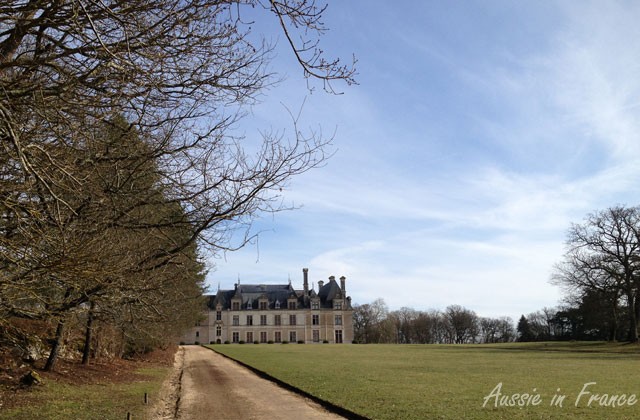
The château started off as a manor house in the 15th century and was confiscated from the owner, François Doulcet, by Louis XII when he was found guilty of embezzlement. François I used the house as a hunting lodge before giving it to his uncle René de Savoie who sold it to Jean du Thier, Henri II’s finance minister in 1545. Work carried out between 1553 and 1559 turned Beauregard into one of the finest châteaux in the Loire Valley. A gallery and an L-shaped wing were added to the original building.
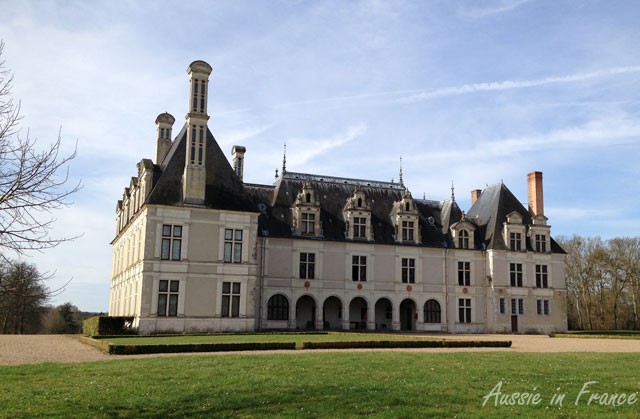
The harmonious Italianised architecture includes arcades in the gallery surmounted by terracotta medallions. Its high white chimneys “à la Chambord” are incrusted with slate. All that remains of Jean du Thier’s interior decoration, however, is the Cabinet des Grelots, his work cabinet, with its delicately sculpted caisson ceiling completed in 1554 by the royal cabinetmaker Scibec de Carpi. The name grelot is derived from Jean du Thier’s coat of arms: 3 gold bells (grelots) on a blue background.
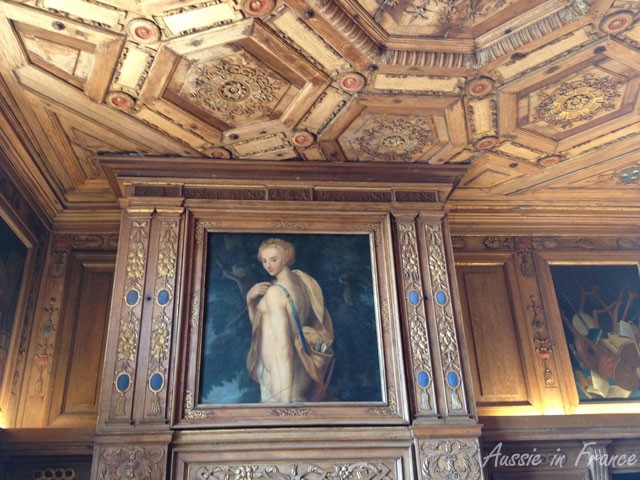
But it was Paul Ardier, Louis XIII’s minister who was responsible for its most prominent feature. After retiring from political life, he decorated the Grand Gallery between 1620 and 1638 with 327 portraits spanning three centuries (1328 to 1643), forming the largest collection of historical portraits in Europe. They are not all works of art, of course, but the collection is impressive.
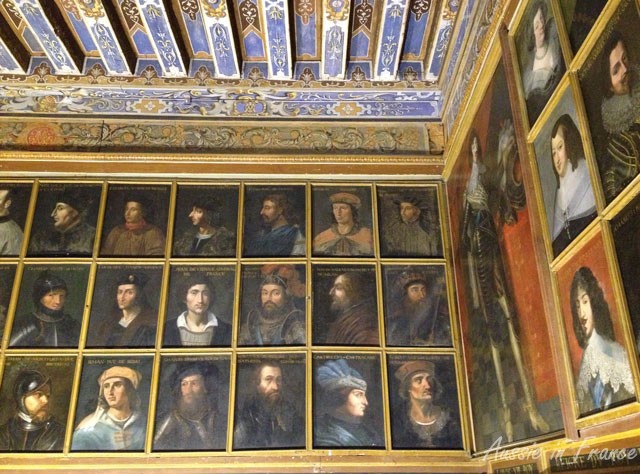
Ardier’s son and granddaughter added the Delft floor tiles, lapis lazuli ceiling and sculpted murals. The Ardier family left the château in 1816.
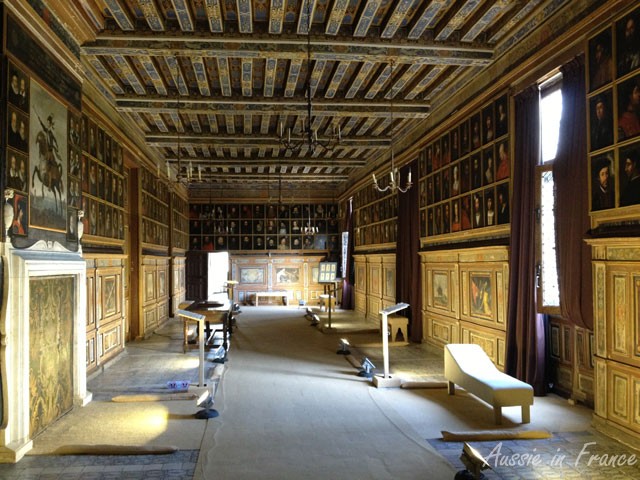
The west wing was destroyed in the 19th century and a second gallery built on the south side. It was modernised in the 20th century by the Tillier family before being bought by the Pavillon family in 1925. It was opened to the public in 1957. Restauration is ongoing and the landscaped park has now been completely restored.
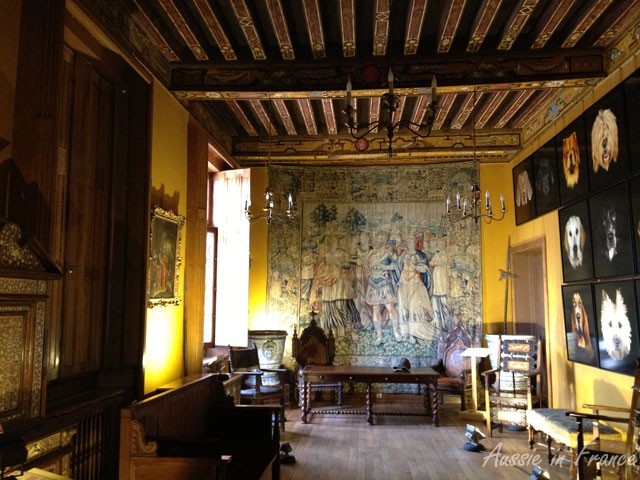
The château also houses a portrait exhibition of dogs owned by famous people. The International Animal Portrait festival was launched in 2012.
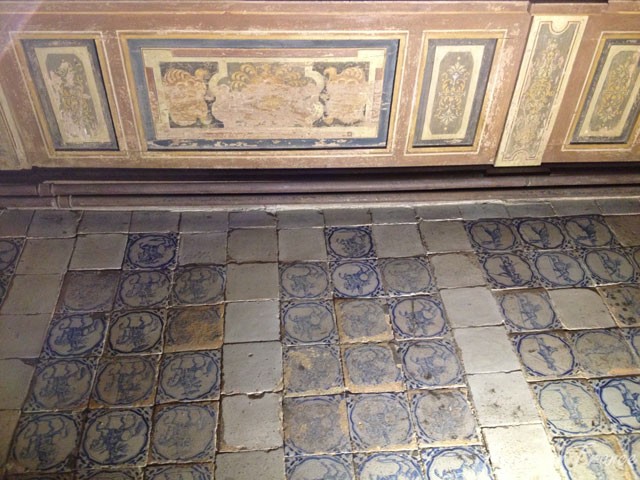
We did not explore the grounds which are obviously not their best in mid March. The Cabinet des Grelots and the Portrait Gallery in particular are quite exceptional but the other rooms are somewhat disappointing.
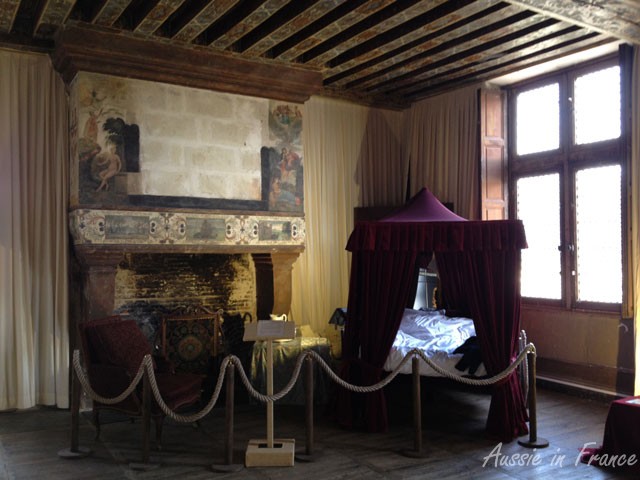
Some effort has been made to recreate the atmosphere in one of the bedrooms but I’m afraid it’s not very convincing. Dog lovers, however, will no doubt appreciate the exhibition, even if it seems a little incongruous.
Opening hours 18th November to 14th February, by reservation only (groups). 15th February to 30th March 11 am to 5 pm, 31st March to 29th June, 10 am to 6 pm, 30th June to 31st August, 10 am to 7 pm, 1st September to 2nd November, 10 am to 6 pm, 3rd November to 11th November, 11 am to 5 pm. Restaurant open from 10.30 am to 6 pm from 1st to 29th May, July and August. Prices Park and château : 12.50 euro (park only : 9 euro); children from 5 to 13 : 10 euro (park only : 9 euro)This year we ARE sitting in front of a roaring fire in the renovated upstairs fireplace, unlike last year when we decided not to herald in the New Year until the renovation was finished. We finally lit our first fire on February 28 only to the discover it smoked. The problem was eventually solved in March when the roofer opened up the top of the chimney. By then it seemed a little late to welcome in the New Year.
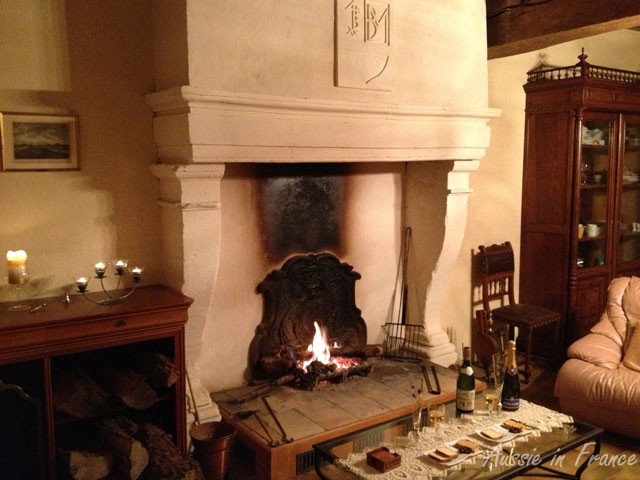
Having just reread my resolutions, plans and expectations for 2012, I see that I have failed miserably with the first, which was NO MORE RENOVATION until we move here permantly. Yes, well, I haven’t mentioned it because it isn’t finished (ha! ha!) but Jean Michel is making an upstairs kitchen because once we got the fire going in October, we decided it would be cool – or should I say warm – to have breakfast and apéritifs dinatoires in the upstairs living room.
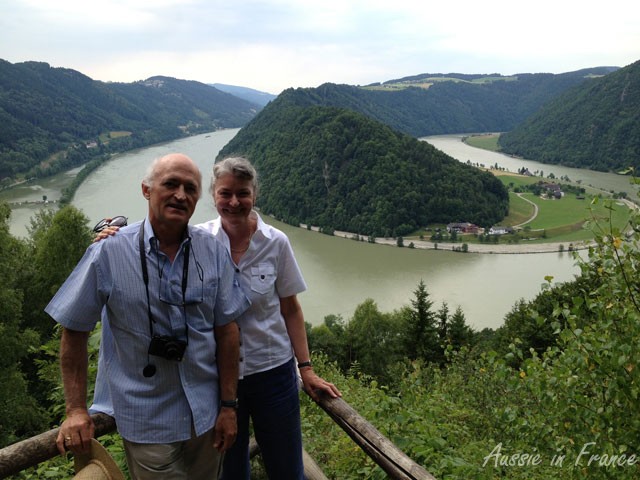
I’ve done better with the second resolution to travel more in Europe. We loved Barcelona and our cycling trip along the Danube in the summer which included Germany, Austria, Slovakia, Hungary and Switzerland, was undoubtedly my best holiday ever. We also unexpectedly went to Sofia and Plovdiv (which reminds me I still have a post to write …).
My third resolution was to go back to fitter occupations and lose the 3 or 4 kilos I’d gained. No problem about that one – our 1,100 kilometers of cycling along the Danube plus all the other shorter cycling holidays have certainly made me fitter. Discovering the 5:2 fast diet is now a way of life. I lost the extra kilos and am now able to enjoy foods I thought I had banished forever.
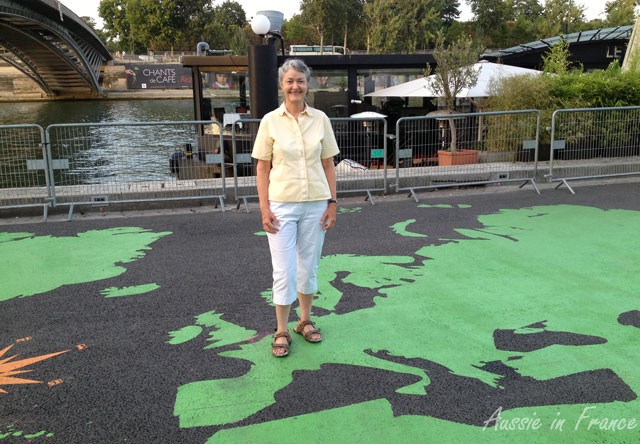
I’m not sure about my fourth resolution of getting out and about in Paris more. I certainly did during the summer months particularly on the banks of the Seine, but as the days get shorter, so does my resolve. I do have the excuse of being in Blois a lot during the winter!
The last resolution was to make the most of my iPhone camera particularly at night. I did learn to do fashion shoots when Black Cat was setting up her sewing blog and I created a second photo blog, Blois Daily Photo, in July but I haven’t made any progress with night photography so I can put that back on the list!
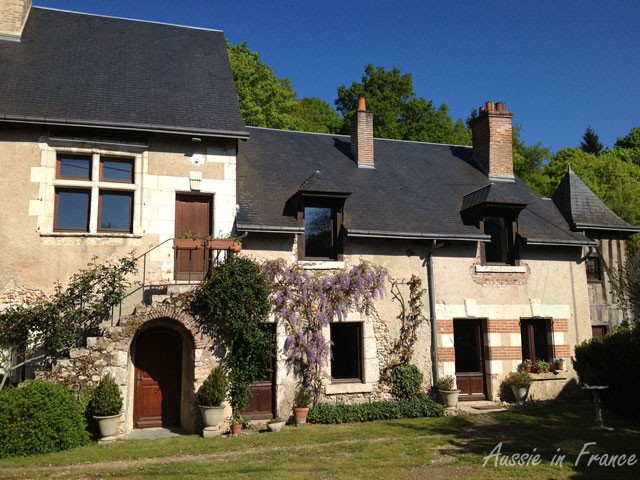
My first resolution for 2014 is to have a maximum number of holiday bookings for Closerie Falaiseau between 1st April and 30th September. We rented for a total of 19 weeks in 2013 so are not far off our goal. All our guests were lovely and gave us wonderful reviews. One extremely nice American couple came back again and have already booked for 2014.
The second resolution is a bit tougher. I’d like to diversify into some sort of tourist-related activity in Blois but it still needs a lot of defining and requires more energy than I seem to have at the moment. Maybe along the lines of the THATlou treasure hunt, walking tours, visits to châteaux, mushroom picking, organisation of short stays in the Loire Valley …
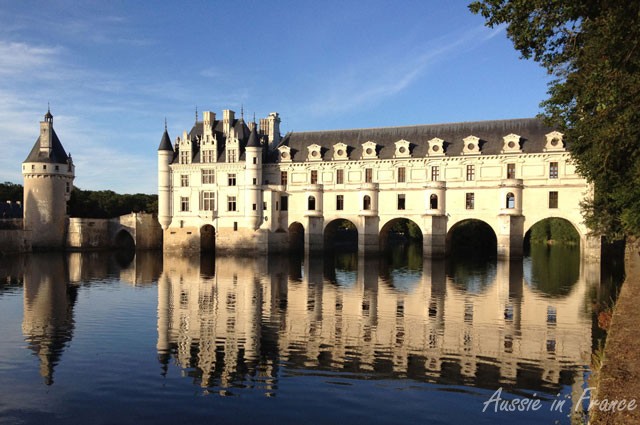
Another long cycling holiday is my third resolution so we’ve started looking at the map. Perhaps in the northern part of Germany along the Rhine. In the meantime, we have organised a home exchange in Venice at the end of April!
My fourth resolution is to discover the secret of getting enough sleep. Maybe if I set it as a goal, I might actually be able to do something about it! Who knows?
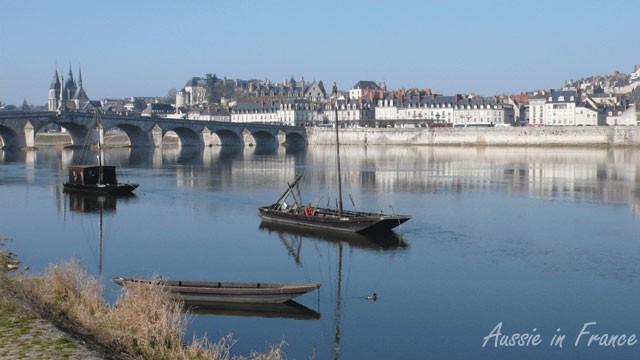
And the 5th is improving my night photography skills.
How about you? What are your new year’s resolutions for 2014?
As one of my friends so cleverly put it: may 2014 bring what 2013 forgot!
Today was our last day of summer in Blois. And, despite the sun, there was a slight chill in the air. We know that the next time we go there, in mid-September, autumn will be on its way. We had hoped that waiting until Monday night to go back to Paris after the Assumption weekend would mean less traffic, but we’re not so sure.
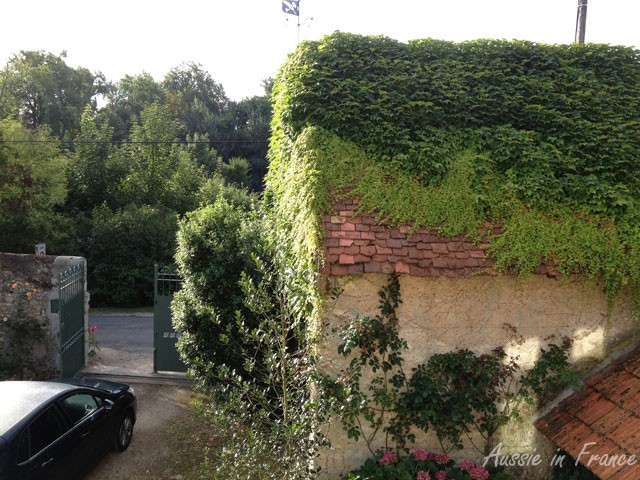
Before we left the house this morning, we chatted with our current guests at Closerie Falaiseau, Karin and Lothar from Stendal in Germany which is a mere 2,200 kilometers from Blois. They drove 1500 K the first day and 700 K the second , which sounds very Australian, doesn’t it? Karin explained that their home town of Stendal has a French connection. The well-known French author, Henri Beyle, author of Le Rouge et le Noir and La Chartreuse de Parme (1783 to 1842), is believed to have chosen the pseudonym of Stendal in hommage to the German writer Winckelmann from the town of Stendal.
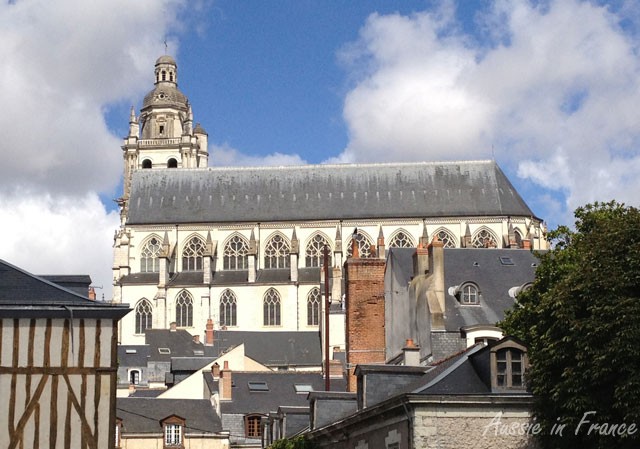
The first thing on the programme for the day was a photo shoot in Blois as we wanted to take enough photos for Blois Daily Photo to last until we come back again. I just took my iPhone but Jean Michel took his Canon 1DS 24/36 which has a special lens that takes photos of buildings without distorting them, unlike mine where I have to stand as far back as I can.
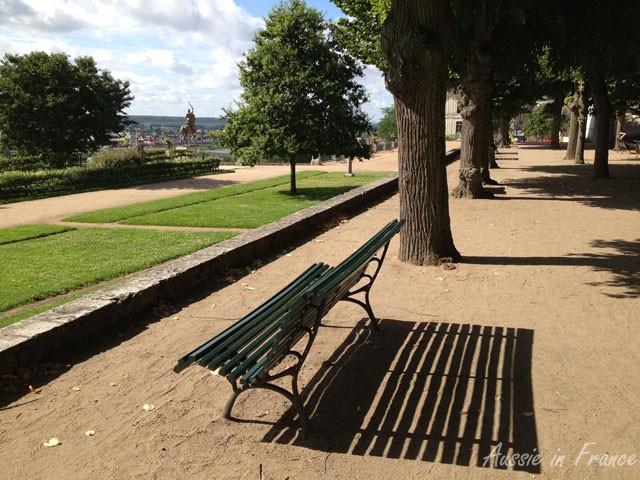
We parked along the Loire on the Mail which is what they called the Esplanade here and wandered up the hill to the Jardin de l’Evêché (Bishop’s gardens) behind the Cathedral, feeling very much on holidays. I love the shadows cast by the morning light.

Our last port of call was the Saint Jacques fountain which I had discovered on a previous occasion. It’s just next to the Restaurant de la Fontaine Saint Jacques. I asked the waiter if it would be alright if we momentarily took down the Sangria sign and he very kindly removed it until we’d finished our photos.
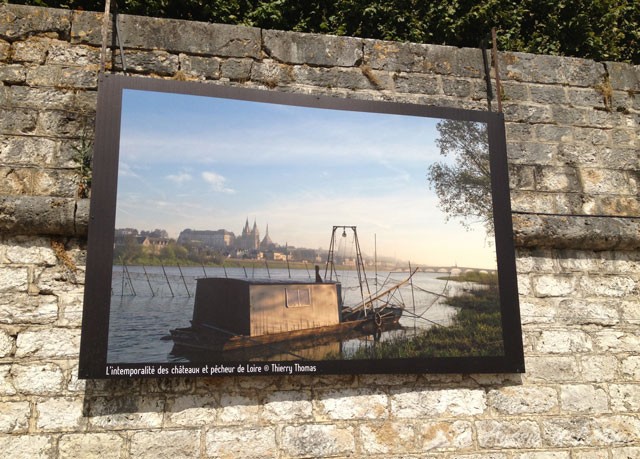
Before leaving Blois, we checked out this year’s amateur photo competition on the banks of the Loire. Next year, we hope we’ll be able to enter it. This year’s theme was “L’insolite” – the unexpected. My favourite photo was an old gabarre flat-bottomed fishing boat by Thierry Thomas.
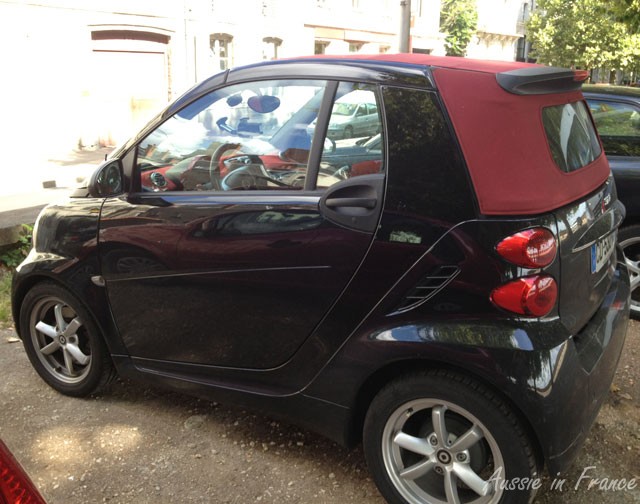
And, coincidentally, what should be parked just next to us on the Mail? This very snazzy rouge et noire Smart Car!
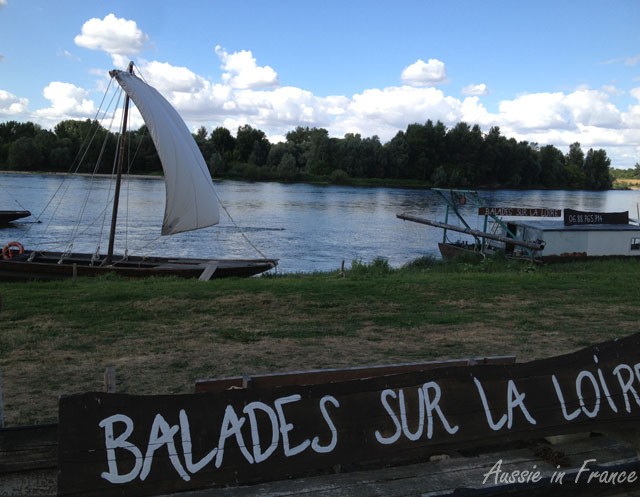
After a late lunch, we packed the car and drove to Chaumont to try out a new cycling itinerary, upriver a short distance, then down to Valliers les Grandes, across to Souvigny en Touraine, up to Mosnes, then along the river again to Rilly sur Loire and back to Chaumont.
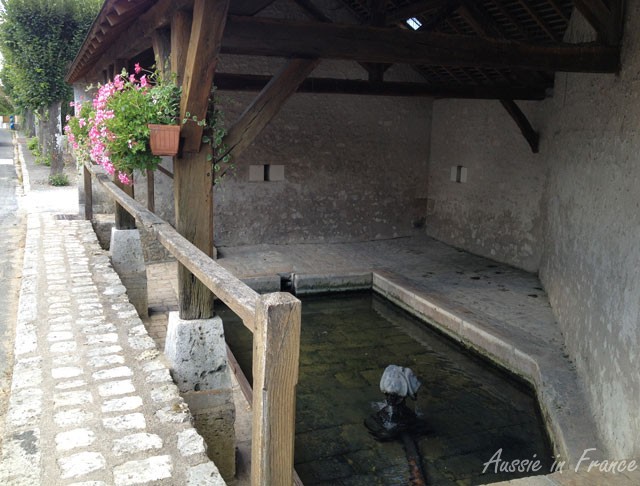
It turned out to have lots of hills, especially quite a steep one at the beginning. We saw two lavoirs, four churches and several historical homes and lots of sunflower fields which in French are called tournesol . I always thought they turned in the direction of the sun. However, these were facing east and not west. Perhaps someone has an explanation.

I had just remarked that we hadn’t seen any hot air balloons – you can usually see a half a dozen in the sky at once late afternoon and early morning – when we saw one just ahead of us and quite low down, travelling very quickly towards Chaumont and no doubt on to Chenonceau.
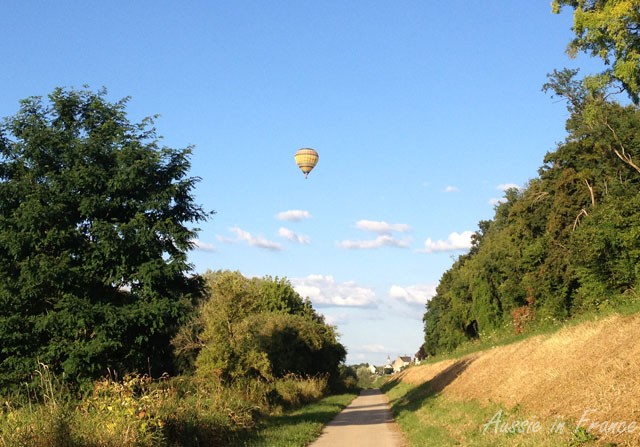
The original 25 kilometers somehow turned into 35 because we changed the starting point and took a wrong turning at one stage and it was 8.30 by the time we got back to the Little House for our last barbecue of the season. And now we’re sadly on our way back to Paris and work.
When is a castle not a castle? When it’s a chateau.
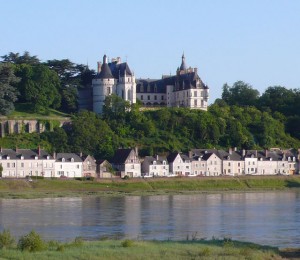
The two words have the same Latin origin – castellum, meaning fortress. The transformation from ca to cha in French is very common : cat/chat, cauldron/chaudron, cart/charrette, etc. In château, the “s” has done its usual disappearing act and turned into a circumflex e.g. pasta/pâte, feast/fête, master/maître. Then the “l” has been vocalised which means that it has become a vowel, which is another typical change, witness by camel/chameau and cauldron/chaudron above.
What is generally called a castle in English is actually a château fort in French. Prime examples are Chinon and Angers. Fort means strong and is obviously at the origin of fort/fort and fortress/forteresse. We have our Anglosaxon word stronghold. Châteaux forts had moats/fosses, ramparts/ramparts, towers/tours and keeps/donjons.
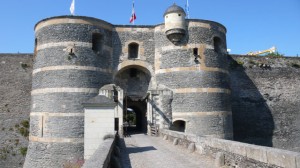
A château does not have to be fortified, nor even be royal, so what can and cannot be described in French as a château is somewhat nebulous.
The châteaux in the Loire Valley, such as Chenonceau, Chaumont and Chambord, were never built to offer protection but they were mostly owned and built by royalty. Others, such as Azay le Rideau and Villandry, were often stately homes built by rich financiers and such like with all the trappings of a château. I guess they could roughly be described as pleasure castles.
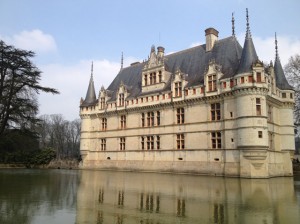
The plural of château in French is châteaux, but in English you can choose between châteaux and chateaus and there’s no obligation to keep the circumflex or chapeau as it’s often called in French.
There are two other common uses of the word château. In the Bordeaux area (bordeaux wine is written with a small letter, by the way, in both French and English), all vineyards are châteaux whether big or small. The same does not apply to other wine-growing areas in France (but the small letter still applies – champagne from Champagne, burgundy/bourgogne from Burgundy/Bourgogne, chinon from Chinon).
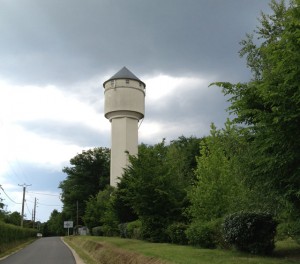
Then there is the château d’eau which is a water tower and, to me, is the strangest use of the word. They certainly don’t look like castles. I have to be honest and say that I had never noticed any water towers in Australia but in France, you can’t miss them!
Last, by not least, we have the château de cartes which is our humble house of cards.
Château de Villesavin, which isn’t really a castle, is an hour’s ride on horseback from Château de Chambord and was actually a glorified worksite hut built at the beginning of the 16th century by Jean Le Breton who was François I’s minister of finance and in charge of construction of his “hunting lodge“. The inside of the building isn’t particularly interesting, except for the “try-out” for the monumental staircase at Chambord and the kitchen, which has a few original features. Photographs of the interior are not allowed, unfortunately. More interesting is the 19th century wedding museum with its large collection of wedding dresses, headdresses and globes!

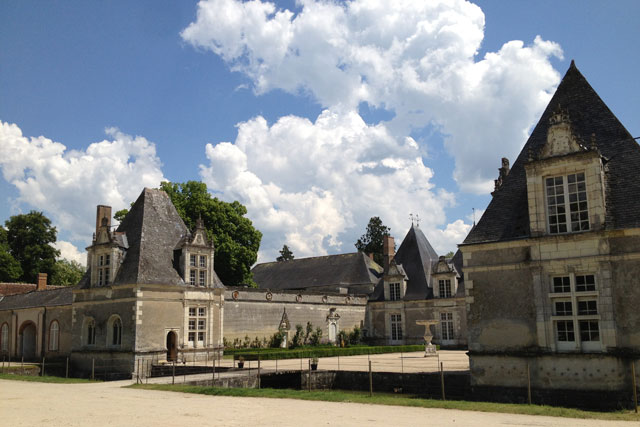

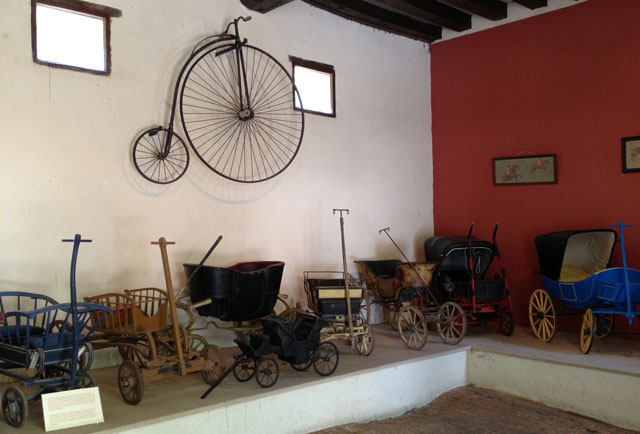
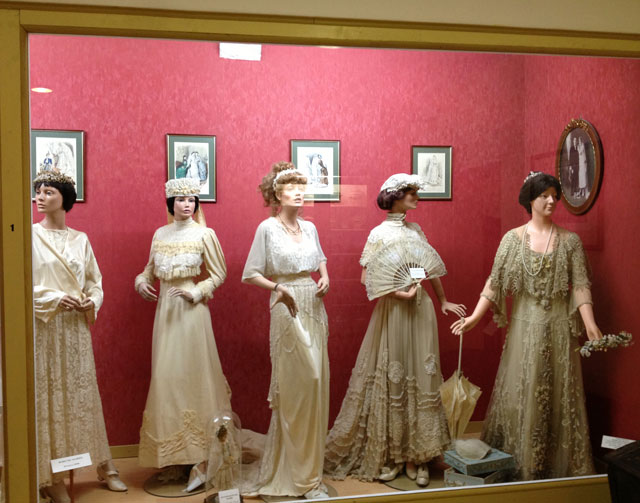

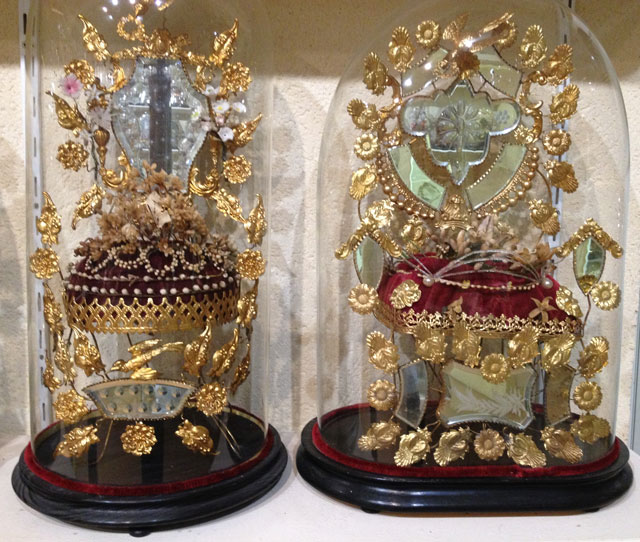
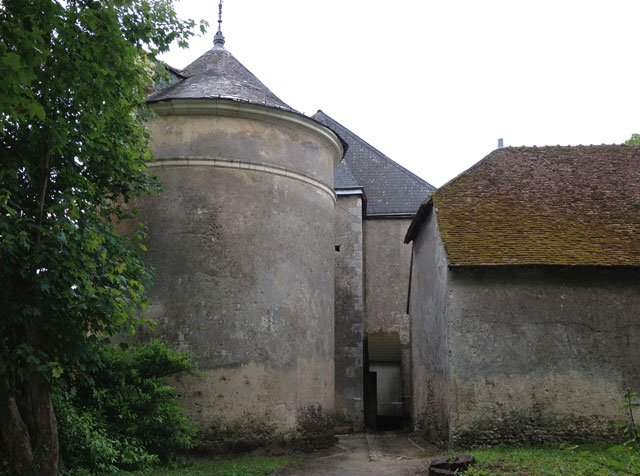
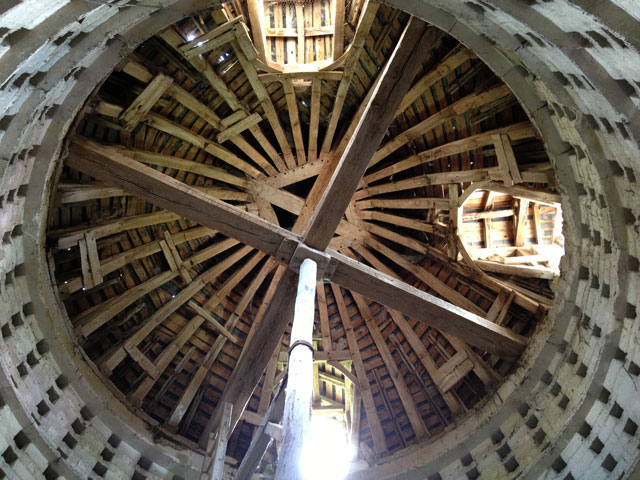
Château de Chenonceau has always been one of my favourites and is definitely among the top ten châteaux in the Loire. In recent years, we’ve cycled along the path on the opposite side several times and taken some wonderful photos of outside but we haven’t visited the interior for some years.
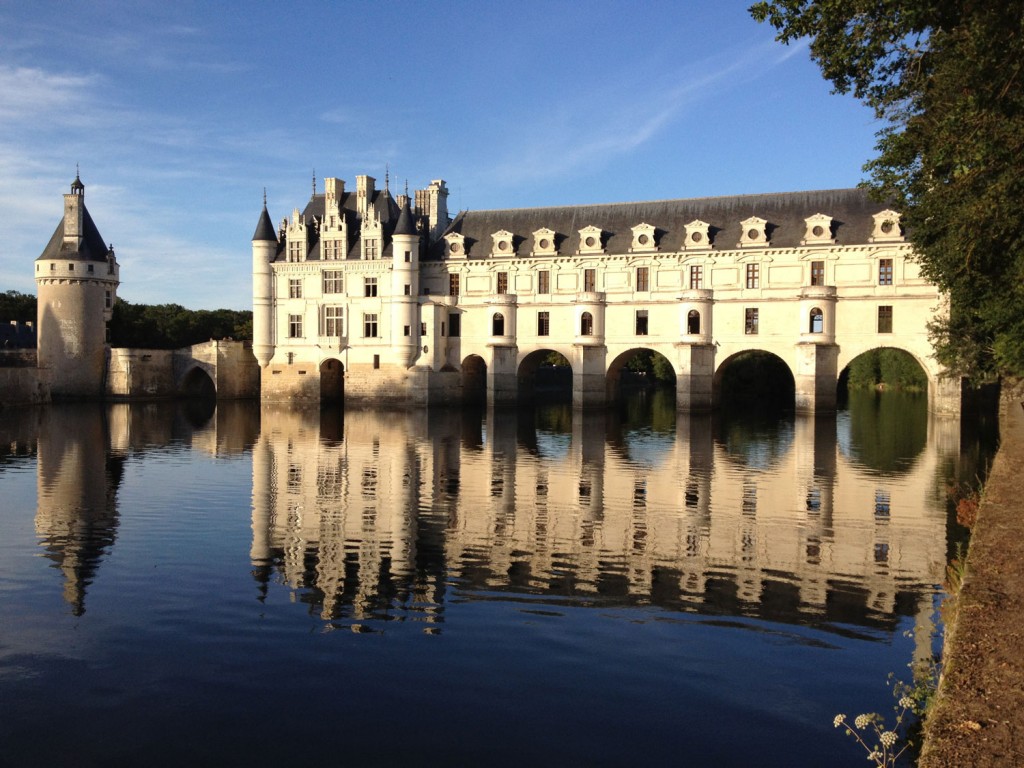
The weather was supposed to be better but it turned out to be too cold to cycle (14°C) with occasional light showers, despite the fact that we’re already in the second half of May. So we decided to visit Chenonceau which is 40 minutes from Closerie Falaiseau.
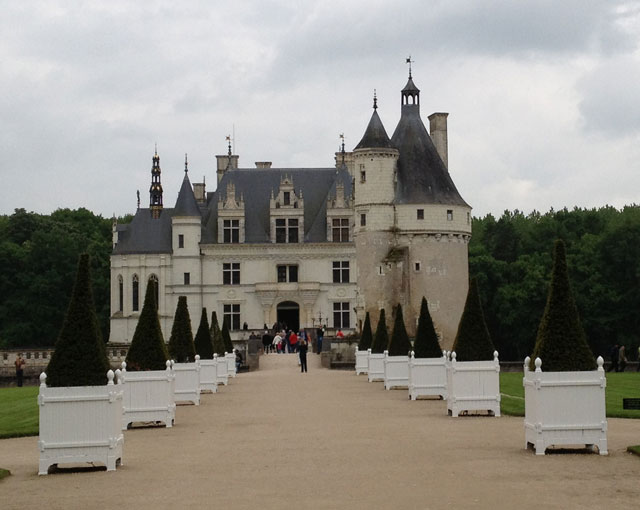
We were surprised to see the parking lot was quite full. There seemed to be a lot of older people milling around, no doubt with guided tours. There are automatic ticket machines though which meant we didn’t have to queue.
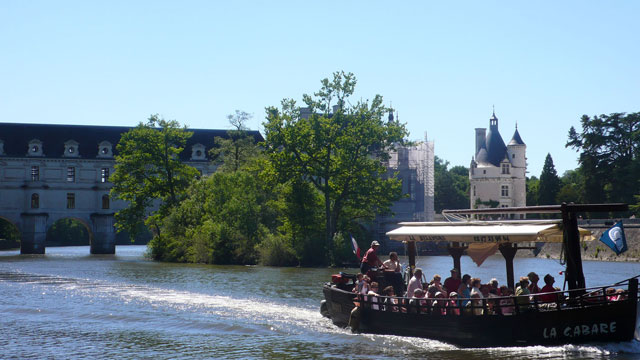
Chenonceau is a ladies castle, as I’ve already mentioned in another post with photos of the outside of Chenonceau from the bike path. It was built in 1513 by Katherine Briçonnet, decorated by Diane de Poitiers some 30 years later, extended by Catherine de Médicis, used as a place of reclusion by Louise of Lorraine after the death of her husband Henri III, saved by Louise Dupin during the French Revolution, restored by Marguerite Pelouze in the mid-19th century and turned into a temporary hospital during WWI by Simone Menier. Whew!

Its location on the Cher River is unique. The main gallery, 60 metres long, built by Catherine de Medicis, with its chequerboard slate-tiled floor and magnificent Renaissance fireplace at each end, spans the river, offering incredible vistas on both sides.
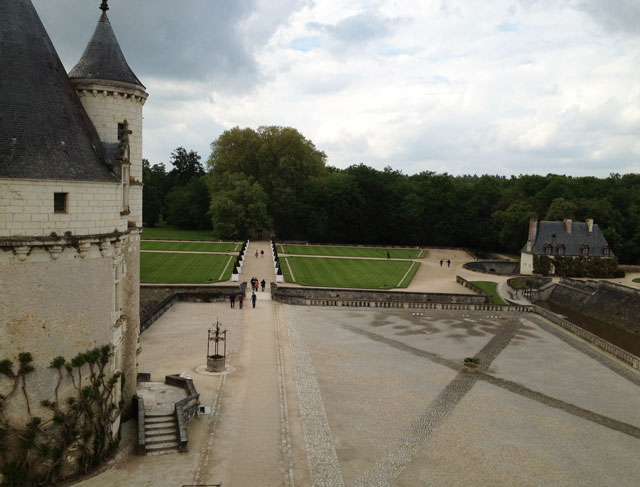
The original keep is still standing, on the other side of the bridge from the château, and is covered with thick vines of trumpet creeper.
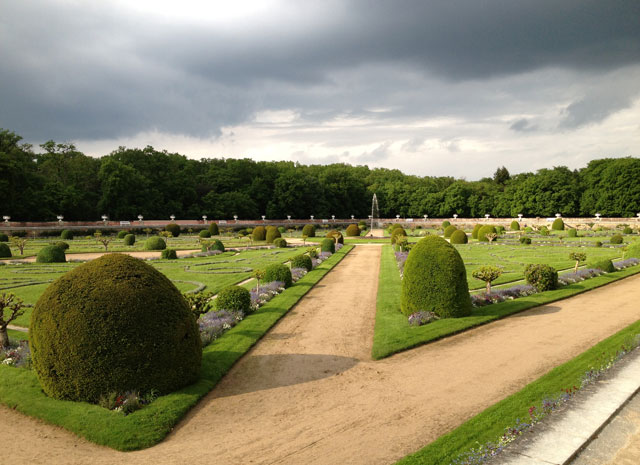
Diane de Poitier’s garden with its eight triangular lawns and climbing iceberg roses can be seen to the left of the château while Catherine de Medici’s more intimate garden, with only five lawns, is on the right. Both offer wonderful views of the château but the best, in my view, are still across the other side.
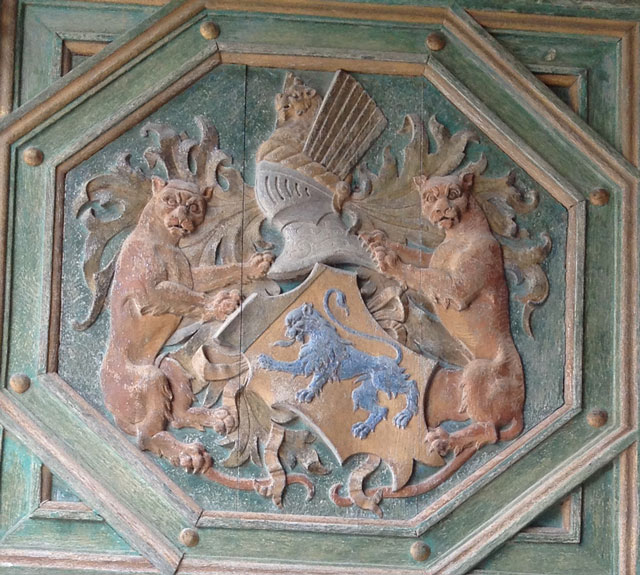
Each room is more sumptuous than the last, although little of the original furniture and furnishings remain, one notable exception being the beautiful painted, sculpted wood door bearing the arms of the first owners, Thomas Bohier and Catherine Briçonnet.
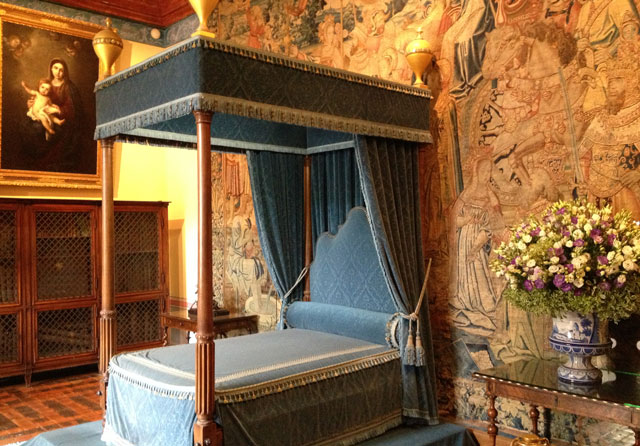
Diane de Poitier’s bedroom with its magnificent 4-poster bed was restored by Madame Pelouze. The fireplace is engraved with the initials of Henri II and Catherine de Medicis, H and C, which, when intertwined can form the D of Diane de Poitiers, Henri II’s favourite – and incidentally the mistress of his father, François I – to whom he gave the château which originally belonged to Catherine de Medicis.

After his death, however, Catherine claimed it back, in exchange for Chaumont. Her bedroom has magnificently carved furniture and a rare set of Flanders Tapestries remarkable for their borders of animals symbolizing proverbs and fables. A painting by Correggio depicting The Education of Love, is one of the château’s many masterpieces, and my favourite.
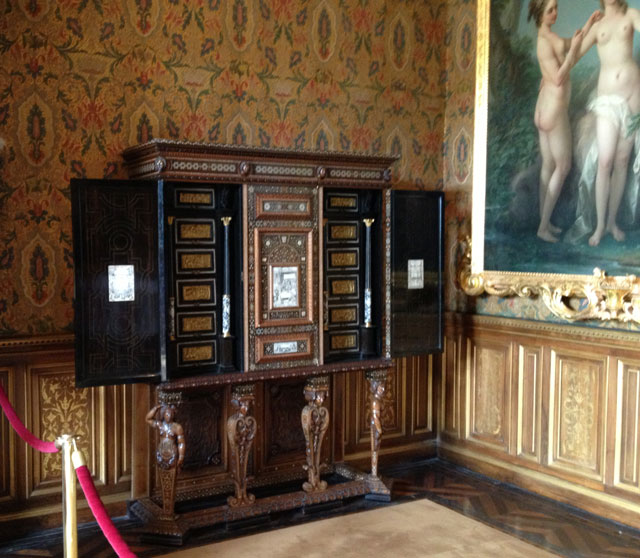
In addition to an exceptional Renaissance fireplace and a remarkable 16th century Italian mother-of-pearl and ivory incrusted cabinet, François I’s drawing room has paintings by Van Dyck, Mancini, Ribera and Van Loo and a portrait of Diane the Huntress by Primaticcio.

The salamander and ermine, the emblems of François I and Queen Claude of France on the gold-embossed Renaissance fireplace in Louis XIV’s drawing room, almost pale in contrast with Rigaud’s portrait of the king its extraordinary gold frame. There is another collection of 17th and 18th century French paintings.
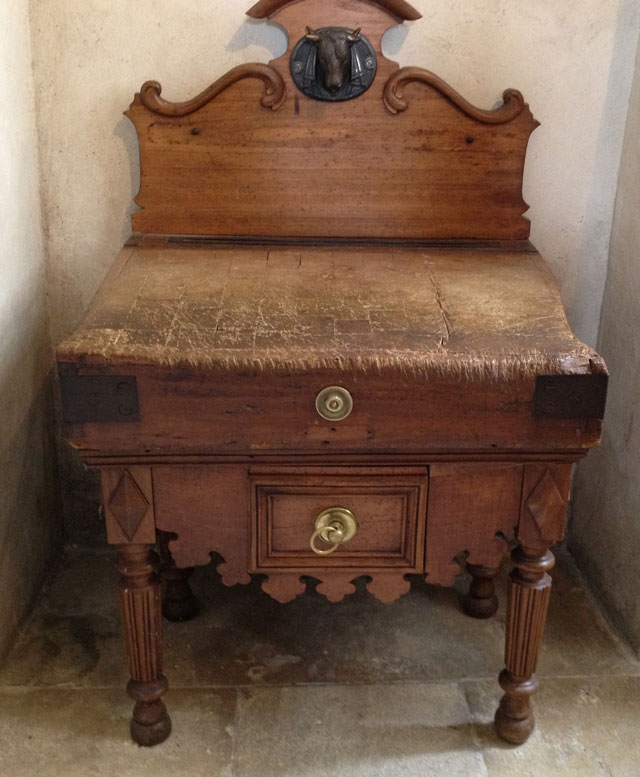
The kitchens at Chenonceau, built in the bases of the piers under the gallery spanning the Cher, are quite remarkable and include a very elaborate butchery. The kitchens were modernised when the château was used as a hospital during WWI. Deliveries were made directly from boats on the river.
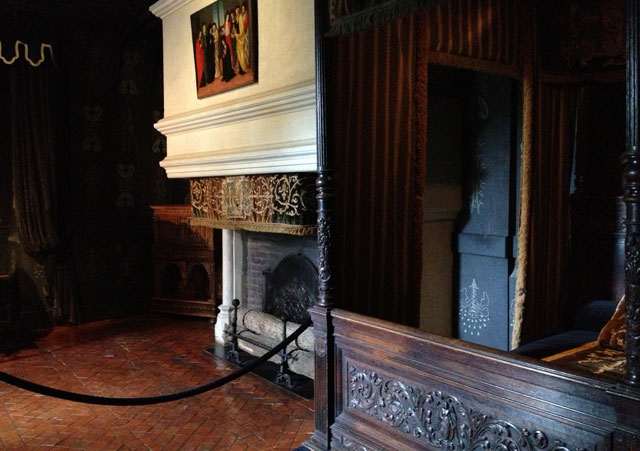
The second floor contains the “gothic” bedroom of the “White Queen”, Louise of Lorraine, where, dressed in the royal mourning colour of white, she prayed and meditated after the assassination of her husband, Henri III.
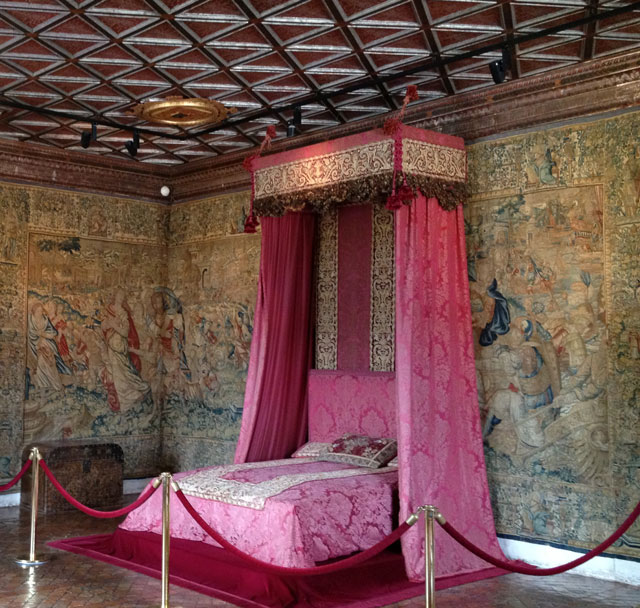
I haven’t described the equally sumptuous bedrooms of César of Vendrôme, Gabrielle d’Estrées and the Five Queens, or the Green Study, the Library, Katherine Briçonnet’s Hall, the Exhibition Room and the Second Floor Hall, but all contain the same high quality furnishings, furniture and masterpieces.

At about 5.30, when we finished visiting the interior, we had a coffee and a disappointing patisserie sitting outside the cafeteria looking toward the château. There were very few people by then, but given the very reasonable prices, I imagine it’s packed at lunchtime. There is also a gourmet restaurant in a beautiful setting (the former Orangery) on the other side of the building with a set menu of 29 euro. Unfortunately, we were too late for teatime (3 to 5 pm).
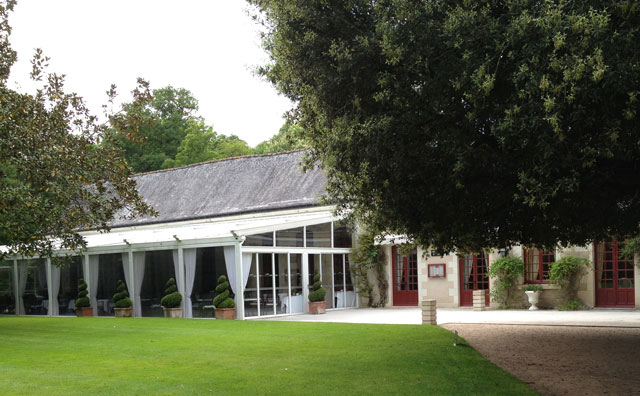
We passed through the wine cellar, where tastings are 2 euro per person. We have a wonderful memory of drinking vintage chenonceau in the Orangery restaurant which we then bought from the cellar, but this time, they were only selling wines from 2010 and 2011 (8 and 10 euro a bottle).
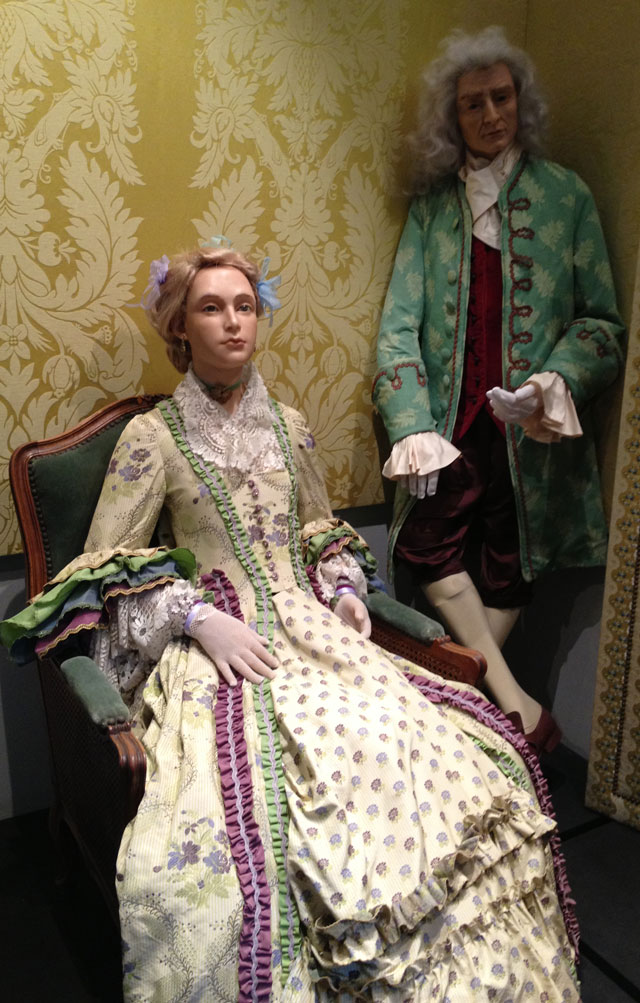
Our visit to the wax museum was very disappointing, except for the costumes which are quite beautiful; the wax models are not of very good quality and don’t resemble the people portrayed. Given the number of foreign visitors, I thought the video at the beginning could have been offered in English as well.

But the biggest surprise was the 16th century farm, including Catherine de Medici’s stables, which I had never seen before. At 7 pm, we were the only visitors. Wisteria, climbing roses and trumpet creepers grace several very charming little houses organised around a circular lawn.
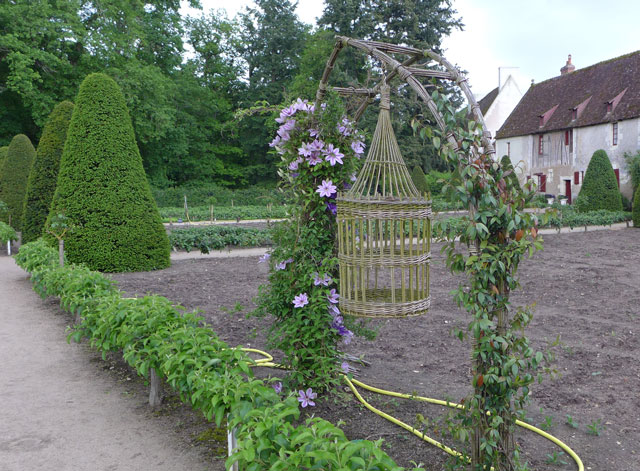
Behind the farm is the vegetable and flower garden which supplies the château’s superb floral arrangements, one in each room, which are worth a post of their own.
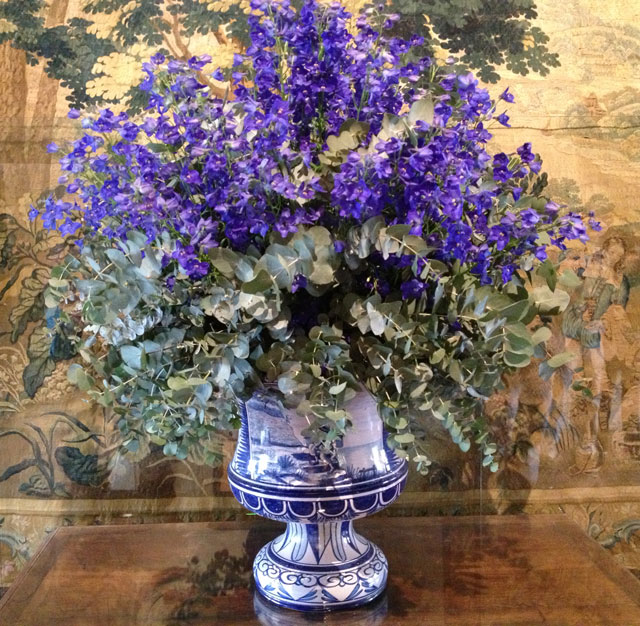
We didn’t see Catherine de Medici’s Italian maze as we ran out of time, but we’ll make sure we see it next time!
Open all year round, 9 or 9.30 am to 5 to 8 pm, depending on the season. 11 euros for the château and grounds, 13 euros including the wax museum, plus 2 euros for an audioguide.
Château de Montpoupon in the Loire Valley, just 10 minutes from Château de Chenonceau, is an excellent example of what can be done to make a small family château attractive to the public. A recorded conversation between a young girl and her father, for example, is used to take the visitor through the living and dining rooms downstairs and the bedrooms upstairs. The extensive 19th century outbuildings contain several exhibitions relating to the Hunt, which was and still is, one of the main activities of the various owners. In particular there is a large display of Hermès scarves which were originally part of the hunting scene. Definitely worth a visit.
